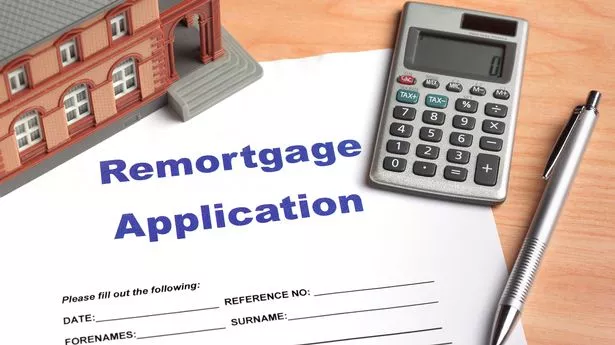What Happens At The End Of An Interest Only Mortgage?

Table of Contents
ToggleInterest only mortgage what happens at the end -
Welcome to our comprehensive guide on what happens at the end of an interest-only mortgage in the UK. If you’re a homeowner with an interest-only mortgage or considering one, understanding the implications and planning for the end of the mortgage term is essential for your financial well-being.
An interest-only mortgage is a unique borrowing arrangement where borrowers pay only the interest on their loan for a specific period, typically 5 to 10 years. At the end of this interest-only period, borrowers face critical decisions shaping their financial future.
In this blog, we will explore the various scenarios borrowers may encounter at the end of an interest-only mortgage, the potential challenges they might face, and the proactive steps they can take to ensure a smooth transition. Whether you’re nearing the end of your interest-only term or just starting your homeownership journey, this blog will equip you with valuable insights and expert advice to make informed choices and secure your financial stability.
1. End of Mortgage Term:
At the end of the mortgage term, borrowers complete the agreed-upon period for which they have made regular mortgage payments to the lender. The loan agreement typically specifies the mortgage term and can range from 15 to 30 years or more, depending on the terms negotiated between the borrower and the lender.
The end of the mortgage term is a significant milestone in homeownership, as it marks the culmination of the borrower’s commitment to repay the loan. Throughout the term, borrowers have been making either interest-only payments or payments that include both principal and interest, depending on the type of mortgage chosen.
For borrowers with a repayment mortgage, reaching the end of the term means they have successfully paid off the entire principal amount borrowed, along with the accrued interest, over the agreed-upon period. It signifies the completion of their mortgage journey and attaining full homeownership, as they now own the property outright, and the lender’s claim on the property is fully satisfied.
For borrowers with an interest-only mortgage, the end of the term signifies that the interest-only payment period has ended. However, it is important to note that with an interest-only mortgage, the principal amount borrowed remains unpaid at the end of the term. This means that borrowers with interest-only mortgages must address the loan’s remaining balance, either by refinancing, making lump-sum payments, or finding alternative means to repay the principal amount.
At the end of the mortgage term, borrowers may also have the option to review their mortgage agreement, consider different mortgage products, or negotiate new terms with the lender, depending on their financial situation and goals.
Overall, the end of the mortgage term is a crucial stage for borrowers to evaluate their options carefully, plan for the future, and ensure that they have a clear strategy to address any remaining mortgage debt or celebrate the completion of their
2. Principal Amount Due:
The “Principal Amount Due” refers to the remaining balance of the original loan amount the borrower still owes to the lender at the end of the mortgage term. It represents the portion of the loan that the borrower borrowed to finance the purchase of the property or to refinance an existing mortgage.
During the mortgage term, borrowers make regular payments to the lender, typically consisting of interest charges and a portion of the principal amount. In the case of a repayment mortgage, each payment gradually reduces the principal balance. However, for borrowers with an interest-only mortgage, the regular payments cover only the interest charges, leaving the principal amount unchanged.
At the end of the mortgage term, the principal amount due represents the total amount the borrower still needs to repay the lender. This amount is usually zero for borrowers with a repayment mortgage, as they would have fully repaid both the principal and interest by the end of the term. They own the property outright.
On the other hand, for borrowers with an interest-only mortgage, the principal amount due remains unpaid at the end of the term. This means that they must find a way to address this remaining balance. Some common options include:
- Refinancing: Borrowers can consider refinancing their interest-only mortgage into a repayment mortgage, where they start making regular payments that include both principal and interest. This allows them to begin reducing the principal amount owed.
- Lump Sum Payment: Borrowers may make a lump sum payment toward the principal to reduce the outstanding balance.
- Selling the Property: Some borrowers may decide to sell the property and use the proceeds from the sale to pay off the remaining balance.
- Alternative Repayment Plan: Borrowers can work with their lender to establish an alternative repayment plan that suits their financial situation and ability to repay the principal amount.
Borrowers with interest-only mortgages must plan and have a strategy to address the principal amount due at the end of the term. Failure to do so could lead to financial difficulties and, in extreme cases, the risk of repossession by the lender.
3. Refinance Option:
The “Refinance Option” at the end of the mortgage term refers to the opportunity for borrowers to take out a new mortgage to replace the existing one. Refinancing allows borrowers to renegotiate their mortgage terms, interest rate, and repayment structure to suit their current financial situation and goals better.
When considering the refinance option at the end of the mortgage term, borrowers may have various reasons for doing so:
1: Transition from Interest-Only to Repayment Mortgage (Interest-Only Mortgage):Borrowers with an interest-only mortgage may refinance to transition to a repayment mortgage. With a repayment mortgage, borrowers make regular payments that include both principal and interest, allowing them to start reducing the outstanding loan balance.
2: Lower Interest Rate:If market interest rates have decreased since the original mortgage was taken, refinancing can allow borrowers to secure a new mortgage with a lower interest rate. This can result in lower monthly payments and potentially significant interest savings over the life of the loan.
3: Accessing Equity: Refinancing also allows homeowners to access the equity they have built up in their property. Borrowers can take out a larger mortgage than their current outstanding balance and receive the difference in cash. This cash-out can be used for various purposes, such as home improvements, debt consolidation, or other financial needs.
4: Changing Mortgage Terms: Borrowers may choose to refinance to change their mortgage term. For example, they may switch from a 30-year mortgage to a 15-year mortgage to pay off the loan sooner or extend the term to reduce their monthly payments.
5: Switching Lenders: Refinancing allows borrowers to switch lenders if they find more favorable terms and conditions elsewhere.
Before deciding to refinance, borrowers should carefully consider the costs associated with refinancing, such as application fees, closing costs, and potential prepayment penalties. They should also assess their financial situation, long-term goals, and evaluate whether refinancing aligns with their overall financial strategy.
4. Qualifying for Refinancing:
Qualifying for refinancing involves meeting certain criteria set by lenders to be eligible for a new mortgage that will replace the existing one. Refinancing allows borrowers to renegotiate their mortgage terms, interest rate, and repayment structure, so lenders must assess the borrower’s financial stability and creditworthiness. Here are the key factors that lenders consider when determining if a borrower qualifies for refinancing:
1: Credit Score: One of the most critical factors is the borrower’s credit score. Lenders use credit scores to assess the borrower’s creditworthiness and the likelihood of timely repayments. A higher credit score improves the chances of qualifying for refinancing with more favorable terms and lower interest rates.
2: Income and Employment History: Lenders will verify the borrower’s income and employment history to ensure that they have a stable source of income to support the new mortgage. A steady income stream indicates the borrower’s ability to make regular mortgage payments.
3: Debt-to-Income Ratio (DTI):The DTI ratio compares the borrower’s total monthly debt payments to their gross monthly income. Lenders use this ratio to evaluate the borrower’s ability to manage additional debt. A lower DTI ratio is generally more favorable for qualifying for refinancing.
4: Loan-to-Value Ratio (LTV):The LTV ratio compares the outstanding mortgage amount to the property’s current appraised value. Lenders prefer a lower LTV ratio, representing a lower risk for them. A higher LTV ratio may require the borrower to pay private mortgage insurance (PMI).
5: Equity in the Property: Lenders often view borrowers with more equity in their property more favorably. Higher equity provides a cushion of security for the lender, reducing the risk of default.
6: Payment History: Lenders review the borrower’s payment history on the existing mortgage and other debts. A strong history of on-time payments can increase the chances of qualifying for refinancing.
7: Property Condition and Appraisal: Lenders may require a property appraisal to assess the property’s current value. The condition of the property is also considered when evaluating the refinancing application.
8: Documentation: Borrowers must provide various documents, such as pay stubs, tax returns, bank statements, and proof of assets, to support their refinancing application.
Each lender may have specific qualifying criteria, and the requirements may vary based on the type of mortgage being refinanced. Borrowers should shop around and compare offers from different lenders to find the most suitable refinancing option for their needs.
5. Repayment Plan:
A repayment plan is a structured strategy that borrowers develop to repay the remaining balance of their mortgage, typically at the end of an interest-only mortgage term or when they have an outstanding principal amount due. The repayment plan outlines how borrowers will address the remaining loan balance and become debt-free over a specified period. Here are the key aspects of a repayment plan:
1: Assessment of Financial Situation: Borrowers begin by assessing their current financial situation, including income, expenses, savings, investments, and other assets. Understanding their financial position helps them determine how much they can allocate towards repaying the mortgage.
2: Setting Financial Goals: Borrowers should define their financial goals, such as clearing the mortgage debt within a certain timeframe, reducing interest costs, or maintaining a comfortable level of monthly payments.
3: Budgeting: Creating a comprehensive budget is crucial for effective financial planning. Borrowers should identify discretionary and non-discretionary expenses and prioritize mortgage repayment in their budget.
4: Savings and Investments: Borrowers may use savings or investments to make lump-sum payments toward the principal amount due. This can help reduce the outstanding balance and shorten the repayment period.
5: Additional Payments: Borrowers can commit to making additional payments with regular mortgage installments. These extra payments directly reduce the principal amount, accelerating the repayment process.
6: Debt Consolidation: For borrowers with multiple debts, consolidating debts may be an option to simplify repayments and allocate more funds towards the mortgage.
7: Negotiating with the Lender: Borrowers facing financial challenges may consider discussing their situation with the lender. Lenders may offer temporary relief or adjustments to repayment terms to help borrowers manage their debt effectively.
8: Consider Refinancing: If suitable, borrowers can explore refinancing to switch to a repayment mortgage. Refinancing allows them to start making payments that include principal and interest, reducing the outstanding balance over time.
9: Professional Advice: Seeking advice from a qualified financial advisor or mortgage specialist is essential in developing a well-structured repayment plan. Advisors can provide personalized guidance based on the borrower’s financial goals and circumstances.
10: Consistency and Discipline:Executing the repayment plan requires consistency and discipline. Sticking to the plan and making regular payments is essential to achieve the desired financial goals.
A well-thought-out repayment plan ensures the successful repayment of the mortgage and contributes to improved financial stability and security. Borrowers should regularly review and adjust the plan based on changes in their financial situation or goals. By taking proactive steps and adhering to the repayment plan, borrowers can effectively address the remaining balance and achieve financial freedom.
6. Selling the Property:
Selling the property is an option that borrowers may consider at the end of their mortgage term or when they have an outstanding principal amount due. Selling the property involves transferring ownership to a buyer in exchange for a sale price, which can be used to repay the remaining mortgage balance. Here are the key points to consider when contemplating selling the property:
1: Paying Off the Mortgage: Selling the property allows borrowers to use the proceeds from the sale to pay off the outstanding mortgage balance. After settling the mortgage debt, the borrower can retain any remaining funds from the sale.
2: Appraisal and Market Value: Before listing the property for sale, it is essential to get an appraisal to determine its current market value. The market value will influence the sale price and the amount available to repay the mortgage.
3: Real Estate Agent and Marketing: Many borrowers engage a real estate agent to help them with the sale process. Agents assist in marketing the property, finding potential buyers, negotiating offers, and handling legal and paperwork requirements.
4: Timing and Market Conditions: Consideration of the current real estate market conditions and timing is crucial. Selling during a seller’s market may result in higher sale prices and quicker sales, while a buyer’s market may lead to more competitive pricing.
5: Prepayment Penalties: Some mortgage agreements may include prepayment penalties, fees charged by the lender if the borrower pays off the mortgage early. Borrowers should review their mortgage contracts to understand any potential penalties.
6: Capital Gains Tax: Borrowers should be aware of capital gains tax implications that may apply to the sale of the property. Tax laws vary by location and individual circumstances, so seeking advice from a tax professional is recommended.
7: Repurchasing or Renting: If the borrower intends to remain in the property or invest in another, selling the current property can provide funds for a new purchase. Alternatively, the borrower may rent a property instead of selling it.
8: Relocation or Lifestyle Changes: Selling the property may be a practical decision due to changes in the borrower’s lifestyle, such as job relocation, downsizing, or moving to a different area.
9: Market Demand and Speed of Sale: The demand for properties in the area and the speed at which properties sell may influence the decision to sell. Faster property sales can result in quicker access to funds for mortgage repayment.
Selling the property can effectively clear the remaining mortgage debt and move toward a new financial chapter. However, it is essential to carefully evaluate the decision based on individual circumstances, long-term goals, and the impact on the borrower’s overall financial plan.
7. Risk of Repossession
The “Risk of Repossession” is a potential consequence that borrowers may face if they cannot repay their mortgage or address the remaining balance at the end of the mortgage term. Repossession occurs when the lender takes possession of the property used as collateral for the mortgage due to non-payment or default. Here are the key points to understand about the risk of repossession:
1: Mortgage Default: A mortgage default happens when a borrower fails to make mortgage payments as per the agreed-upon terms in the loan agreement. This can occur during the mortgage term or when the borrower cannot repay the remaining balance, especially in the case of an interest-only mortgage.
2: Breach of Mortgage Agreement: Failure to adhere to the terms of the mortgage agreement, including making regular payments and addressing the remaining principal balance, can be considered a breach of the contract.
3: Lender’s Right to Repossess: When a borrower defaults on the mortgage or fails to repay the remaining balance, the lender has the legal right, as per the mortgage contract, to initiate repossession proceedings.
4: Repossession Process: Repossession involves the lender seeking a court order to take possession of the property. The borrower may be required to vacate the property, and the lender will typically sell the property to recover the outstanding mortgage debt.
5: Impact on Borrower’s Credit: Repossession severely negatively impacts the borrower’s credit score and financial standing. It can make it challenging for the borrower to secure credit in the future and may affect employment opportunities and other aspects of their financial life.
6: Efforts to Avoid Repossession: Borrowers facing financial difficulties or the risk of repossession should proactively communicate with the lender. Many lenders have hardship assistance programs to help borrowers during challenging times. Exploring alternative solutions, such as refinancing or restructuring the loan, may also be viable options.
7: Seeking Professional Advice: If a borrower struggles to make mortgage payments or faces the risk of repossession, seeking advice from a qualified financial advisor or housing counselor is essential. They can guide available options and help the borrower navigate the situation.
8: Early Intervention: Early intervention is crucial in mitigating the risk of repossession. Addressing financial difficulties promptly and seeking assistance can lead to more favorable outcomes.
9: Property Value and Sale Proceeds: If the lender repossesses the property and sells it, the proceeds from the sale are used to cover the outstanding mortgage debt. If the sale proceeds are insufficient to cover the debt, the borrower may still be responsible for the remaining balance.
8. Seeking Professional Advice:
Seeking professional advice is crucial for borrowers facing various financial decisions, especially regarding mortgages. Whether at the end of a mortgage term, considering refinancing, or dealing with financial difficulties, seeking guidance from qualified professionals can provide valuable insights and help borrowers make informed decisions. Here are some key aspects of seeking professional advice:
1: Mortgage Specialists: Mortgage specialists, such as mortgage brokers or mortgage advisors, are experts in the field of mortgages. They can provide comprehensive information about mortgage products, interest rates, terms, and lenders. Mortgage specialists can help borrowers understand the available options and guide them in selecting the most suitable mortgage based on their financial situation and preferences.
2: Financial Advisors: Financial advisors have a broad understanding of personal finance and can offer holistic advice on various aspects of a borrower’s financial life. They can help borrowers develop financial goals, create budgeting strategies, and design long-term financial plans that align with their unique circumstances and objectives. Financial advisors can also assist in evaluating the impact of mortgage decisions on other financial goals, such as retirement planning, investment strategies, and risk management.
3: Real Estate Agents: Consulting with a reputable real estate agent can be beneficial when buying or selling a property. Real estate agents can provide information about the local property market, valuations, negotiating strategies, and legal aspects of property transactions. They can guide borrowers through buying or selling a property and help them make informed decisions based on market conditions and their preferences.
4: Housing Counselors: Housing counselors offer free or low-cost advice to borrowers facing housing-related challenges. They can guide avoiding foreclosure, managing mortgage payments, understanding mortgage documents, and exploring available assistance programs. Housing counselors can be a valuable resource for borrowers experiencing financial difficulties or facing the risk of repossession.
5: Legal Professionals: In complex mortgage situations or legal issues related to mortgages, borrowers may benefit from consulting with legal professionals, such as real estate attorneys. Legal experts can guide mortgage contracts, legal obligations, foreclosure proceedings, and other legal matters related to homeownership and mortgages.
6: Credit Counselors: For borrowers with credit challenges or concerns about their credit score, they can offer advice on improving creditworthiness, managing debt, and building a strong credit history. A better credit score can open up more favorable mortgage and financial opportunities.
7: Government Resources: Borrowers can also seek advice from government agencies and resources that offer information on mortgages, homeownership assistance programs, and financial literacy.
8: Independent Research: Borrowers should conduct independent research and educate themselves on mortgage-related topics. Being informed empowers borrowers to ask relevant questions and make well-informed decisions during professional discussions.
Seeking professional advice helps borrowers gain clarity, avoid costly mistakes, and navigate complex financial situations. It is essential to work with reputable, qualified professionals with the necessary expertise and act in the borrower’s best interest. With the support of professionals, borrowers can make confident decisions that align with their financial goals and contribute to their overall financial well-being.
9. Planning Ahead:
Planning is a critical aspect of managing mortgages and overall financial well-being. It involves taking proactive steps to anticipate future financial needs, set financial goals, and develop strategies to achieve them. When it comes to mortgages, planning helps borrowers make informed decisions, stay on top of their financial responsibilities, and be prepared for potential changes or challenges. Here are key points to consider when planning:
1: Mortgage Term Considerations: At the start of the mortgage journey, borrowers should choose the term that aligns with their financial situation and goals. Whether opting for a shorter or longer term, understanding the implications of each choice is crucial in planning for the future.
2: Budgeting and Affordability: Creating and maintaining a realistic budget is fundamental in managing mortgage payments and other financial obligations. Planning involves evaluating one’s income, expenses, and financial commitments to ensure that mortgage payments are manageable and sustainable.
3: Emergency Fund: An emergency fund is essential to cope with unexpected financial setbacks. Having a financial cushion helps borrowers manage mortgage payments during difficult times, reducing the risk of default.
4: Interest Rate Changes: Considering potential interest rate fluctuations is important, especially for variable-rate mortgages. Planning involves understanding how changes in interest rates could impact mortgage payments and being prepared for rate adjustments.
5: Refinancing Opportunities: Borrowers should stay informed about prevailing interest rates and market conditions to identify potential refinancing opportunities. Refinancing at a lower rate or to a more favorable mortgage product can lead to interest savings and improved financial flexibility.
6: Life Events and Milestones: Life events such as marriage, starting a family, career changes, or retirement can impact financial priorities. Planning involves anticipating how these events affect mortgage affordability and adjusting financial strategies accordingly.
7: Paying Down the Principal: Making extra payments toward the principal amount can shorten the mortgage term and save on interest costs. Planning involves evaluating the feasibility of making additional payments and incorporating them into the financial plan.
8: Retirement and Long-Term Goals: Planning for retirement and other long-term goals requires careful financial consideration. Assessing how the mortgage fits into the financial picture is vital in ensuring a secure retirement and achieving other aspirations.
9: Reviewing Insurance Coverage: Evaluating and updating insurance coverage, such as homeowners insurance, is part of planning ahead. Adequate insurance protection safeguards the property and provides financial security in unforeseen events.
10: Seeking Professional Guidance: Working with financial advisors, mortgage specialists, and other professionals can provide valuable insights into long-term financial planning and mortgage management.
Effective planning ahead empowers borrowers to make proactive decisions that align with their financial goals and circumstances. It helps borrowers navigate changes, mitigate risks, and achieve financial security and prosperity throughout the mortgage journey and beyond.
10. Early Repayment Considerations:
Early repayment considerations refer to the factors and implications borrowers should consider when contemplating making early repayments on their mortgage. Early repayment involves paying off a portion or the outstanding mortgage balance before the scheduled maturity date. While it can be beneficial in certain situations, borrowers should carefully evaluate the following aspects before proceeding with early repayment:
1: Prepayment Penalties: Some mortgage agreements may include prepayment penalties, fees charged by the lender if the borrower repays the mortgage before the agreed-upon term. Reviewing the mortgage contract to understand if such penalties apply and their impact on the overall cost of early repayment is essential.
2: Assessing Financial Priorities: Borrowers should assess their financial priorities before making early repayments. While reducing mortgage debt can be advantageous, it’s essential to consider other financial goals, such as building an emergency fund, contributing to retirement accounts, or paying off high-interest debts.
3: Opportunity Cost: Early repayment involves redirecting funds that could have been invested elsewhere, potentially earning higher returns. Borrowers should consider the opportunity cost of using these funds for early mortgage repayment rather than other investment opportunities.
4: Long-Term Financial Goals: Considering long-term financial goals is crucial. If early repayment significantly impacts the ability to achieve other important financial objectives, borrowers may want to balance their approach to accommodate multiple goals.
5: Emergency Savings: Borrowers should have an adequate emergency savings fund before making early repayments. Having readily available funds for unforeseen expenses is essential to avoid financial strain.
6: Mortgage Interest Savings: Early repayment can result in interest savings over the life of the loan, as the outstanding balance is reduced. Borrowers can use mortgage calculators to estimate interest savings based on their early repayment amount.
7: Loan Term and Interest Rate: The length of the mortgage and interest rates can impact the benefits of early repayment. Borrowers with shorter terms or higher interest rates may experience more significant interest savings from early repayment.
8: Tax Implications: Borrowers should consider any tax implications related to early repayment. In some regions, mortgage interest deductions may be available, and early repayment could affect these deductions.
9: Flexibility and Liquidity: Making early repayments can reduce a borrower’s liquidity and financial flexibility. While reducing mortgage debt is desirable, having liquid assets available for unforeseen circumstances is equally important.
10: Financial Security: Early repayment should maintain a borrower’s financial security. It’s crucial to balance reducing mortgage debt and maintaining financial stability.
Making early repayments can be a wise financial move under the right circumstances, such as when prepayment penalties are not applicable and borrowers have sufficient funds for other financial needs. To make an informed decision, borrowers should assess their financial situation, consider the implications, and seek advice from financial professionals, such as mortgage advisors or financial planners.






